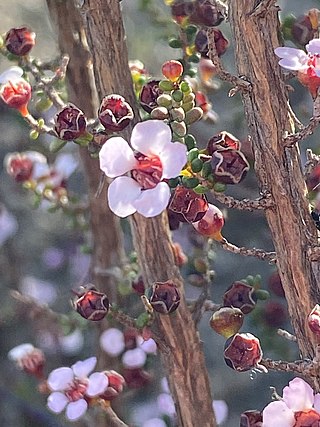
Thryptomene hexandra, commonly known as Palm Valley myrtle in the Northern Territory, is a species of flowering plant in the family Myrtaceae and is endemic to north-eastern Australia. It is an erect, much-branched shrub with linear to lance-shaped leaves and white flowers with six stamens.

Micromyrtus ciliata is a species of flowering plant in the family Myrtaceae and is endemic to south-eastern continental Australia. It is a spreading to erect shrub with crowded, oblong to egg-shaped leaves and small white or pink flowers arranged singly in upper leaf axils, forming clusters on the ends of branches.

Rinzia orientalis, commonly known as desert heath-myrtle, is a species of flowering plant in the family Myrtaceae and is endemic to south-eastern Australia. It is a shrub with elliptic to narrowly oblong leaves and white or pale pink flowers usually with ten stamens.
Baeckea latens is a species of flowering plant in the family Myrtaceae and is endemic to the south of Western Australia. It is an upright, spreading shrub with erect, linear leaves and small white flowers with three to ten stamens.
Baeckea pygmaea is a species of flowering plant in the family Myrtaceae and is endemic to the south-west of Western Australia. It is a slender and erect or spreading shrub with narrowly egg-shaped to almost linear leaves and small white flowers with 12 to 25 stamens.
Micromyrtus acuta is a species of flowering plant in the myrtle family, Myrtaceae and is endemic to the southwest of Western Australia. It is an erect shrub with small, oblong leaves and small white flowers in the upper leaf axils.
Micromyrtus arenicola is a species of flowering plant in the myrtle family, Myrtaceae and is endemic to a small area in the southwest of Western Australia. It is an erect shrub with small, linear to narrowly egg-shaped leaves and small white flowers.
Micromyrtus barbata is a species of flowering plant in the family Myrtaceae and is endemic to inland areas of Western Australia. It is a shrub with small, overlapping, narrowly egg-shaped leaves and small white flowers arranged singly in upper leaf axils.
Micromyrtus chrysodema is a species of flowering plant in the myrtle family, Myrtaceae and is endemic to a small area of inland Western Australia. It is a densely branched shrub with small, narrowly oblong leaves and small white flowers.

Thryptomene australis, commonly known as hook-leaf thryptomene, is a species of flowering plant in the family Myrtaceae and is endemic to the south-west of Western Australia. It is an erect, bushy and spreading shrub with upward-pointing leaves with the tip curving outwards, and flowers with white petals arranged spike-like near the ends of the branchlets.
Thryptomene costata is a species of flowering plant in the family Myrtaceae and is endemic to Western Australia. It is an erect shrub with upward pointing, egg-shaped leaves with the narrower end towards the base, and white or pink flowers with five petals and ten stamens.
Thryptomene dampieri is a species of flowering plant in the family Myrtaceae and is endemic to the north-west of Western Australia. It is a low, spreading shrub with prostrate stems, broadly egg-shaped leaves with the narrower end towards the base, and pinkish flowers with five petals and ten stamens.
Thryptomene johnsonii is a species of flowering plant in the family Myrtaceae and is endemic to a restricted area of Western Australia. It is a bushy shrub with rigid branches, egg-shaped leaves with the narrower end towards the base and pink flowers with five petals and usually eight stamens.
Thryptomene naviculata is a species of flowering plant in the family Myrtaceae and is endemic to central areas of Western Australia. It is a rounded shrub with overlapping, decussate, egg-shaped leaves with the narrower end towards the base and white flowers with five petals and five stamens.
Thryptomene podantha is a species of flowering plant in the family Myrtaceae and is endemic to the west of Western Australia. It is a shrub with egg-shaped leaves with the narrower end towards the base, and flowers with pink sepals and petals and ten stamens.

Thryptomene parviflora is a species of flowering plant in the family Myrtaceae and is endemic to Queensland. It is a slender, erect shrub with decussate, linear to egg-shaped leaves with the narrower end towards the base, and flowers with five petals and five stamens arranged singly in leaf axils.
Cryptandra micrantha is a flowering plant in the family Rhamnaceae and is endemic to the southwest of Western Australia. It is a prostrate or upright shrub with spiny branchlets, narrowly oblong to elliptic leaves and dense clusters of white or cream-coloured, tube-shaped flowers.
Micromyrtus albicans is a species of flowering plant in the myrtle family, Myrtaceae and is endemic to a small area of south-eastern Queensland. It is a slender shrub with overlapping, egg-shaped leaves and small white flowers.
Micromyrtus capricornia is a species of flowering plant in the myrtle family, Myrtaceae and is endemic to a small area of central eastern Queensland. It is a shrub with slightly drooping branchlets, overlapping, narrowly egg-shaped leaves and small white flowers.
Micromyrtus carinata is a species of flowering plant in the myrtle family, Myrtaceae and is endemic to a small area of south-eastern Queensland. It is a slender shrub with drooping branchlets, overlapping, egg-shaped to lance-shaped leaves and small white flowers arranged singly in leaf axils.





